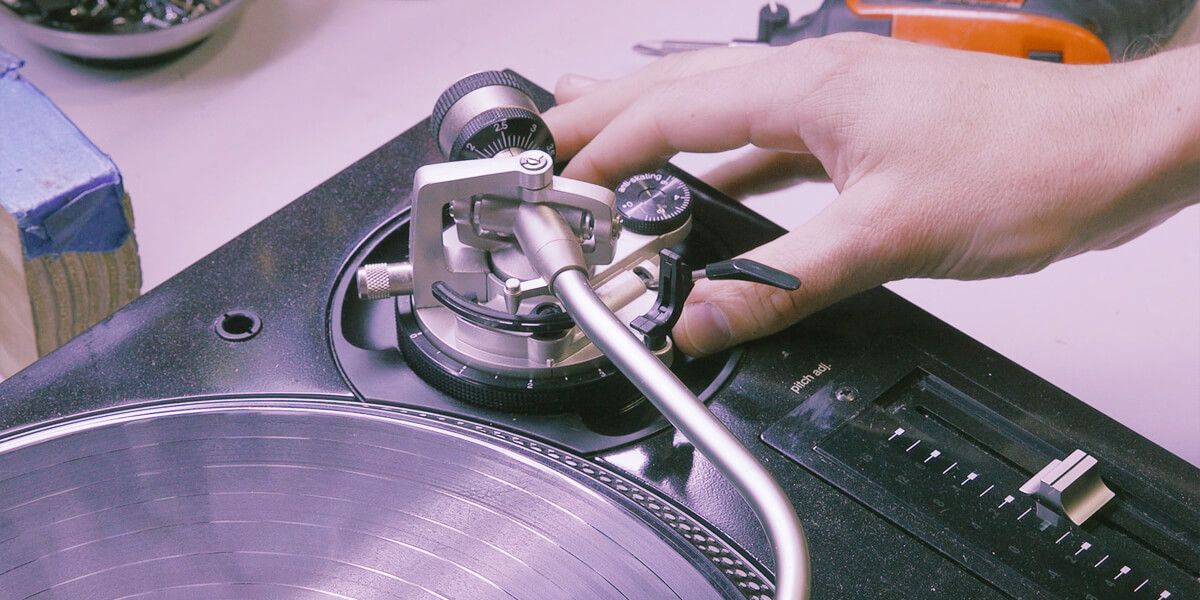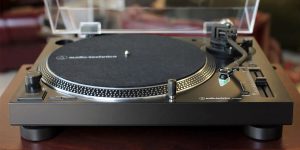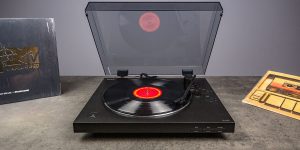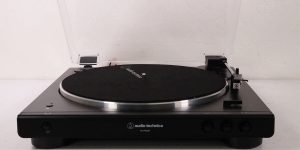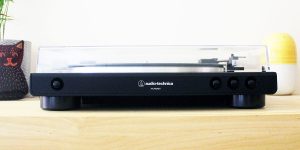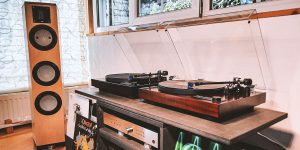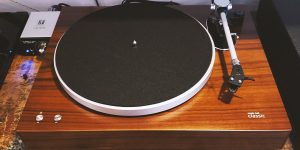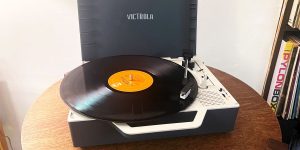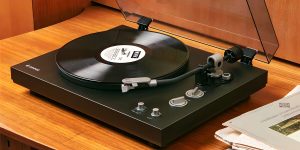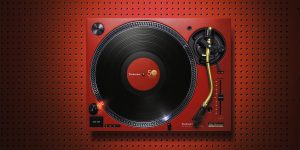The magic of vinyl records lies not only in the grooves but also in the equipment used to bring that music to life. The tonearm is an essential yet often overlooked component of a turntable.
The record player tonearm is the slender detail that holds the cartridge and stylus, allowing them to track the grooves on a vinyl record. In other words, it’s the bridge between the spinning platter and your ears. Thanks to this component, the turntable accurately reproduces the intricate details etched into your favorite records.
But not all tonearms are the same. So you may be wondering which type of tonearm might be the right fit for your turntable setup. Read on as I explore the different types of these components and how each of them can impact your listening experience.
Types of turntable tonearms
Straight tonearms
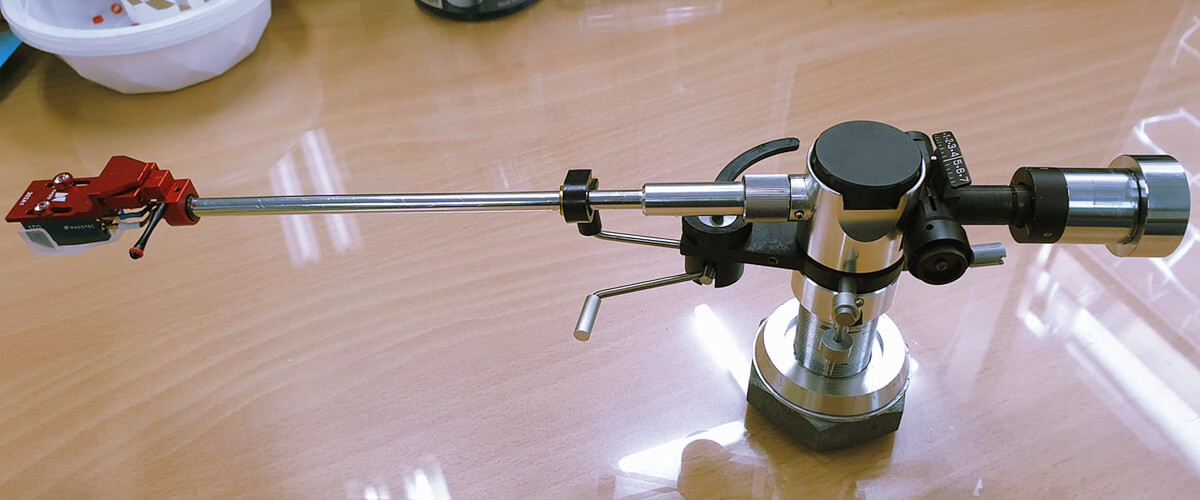
As the name suggests, straight tonearms have a linear design with the cartridge and stylus aligned in a straight line from the pivot point to the needle.
This tonearm type offers superior tracking due to its more accurate alignment with the record grooves. This results in reduced distortion and better sound quality, especially when playing records with challenging passages. Also, it is generally more lightweight and agile, making it ideal for DJing and other situations where you need to have quick stylus movements.
So, if you’re a DJ or someone who values precise tracking and clear sound reproduction, a straight tonearm could be an excellent choice. However, remember that straight tonearms may require more frequent cartridge and stylus adjustments and replacements.
S-shaped tonearms
The S-shaped tonearm is one of the most recognizable types of turntable tonearms. It features a gentle curve that forms an “S” shape. You can find this design on many vintage turntables as well as modern, high-quality models.
The distinctive shape allows for better tracking accuracy and reduced distortion, as the stylus remains at an optimal angle throughout playback. This results in a more precise reproduction of the music on the vinyl record. It is also compatible with a wide range of cartridges. So, you can easily experiment with different cartridge and stylus combinations to find your preferred sound signature.
Mind that an S-shaped record player’s arms tend to be heavier, which can lead to increased resonance and potentially affect sound quality. Additionally, they may have limited adjustability options and can be more expensive than their straight counterparts.
Gimbal tonearms
These models are known for their precise and stable design. They allow smooth movement in both vertical and horizontal planes. You can find them in a variety of turntables, from entry-level to high-end audiophile models. They are compatible with various cartridges and offer adjustable settings for different stylus and record types.
The benefits of gimbal tonearms lie in their stability, low-friction movement, and adjustability. The gimbal bearing system ensures consistent tracking and minimal vibrations, leading to clear sound reproduction.
When considering a gimbal tonearm, prioritize stability and accurate tracking. Also, ensure compatibility with cartridges and styluses you plan to use and look for tonearms with necessary adjustments.
Unipivot tonearms

Such products feature a unique design. They use a single pivot point to support the entire tonearm. This minimalistic approach can be found in turntables ranging from mid-level models to high-end audiophile setups, offering a distinct alternative to gimbal or dual-pivot tonearms.
The advantages of unipivot tonearms stem from their simplicity, lower mass, and ability to convey a more natural sound. The single pivot point reduces friction and allows for free movement, resulting in an organic, open sound that many listeners appreciate. Additionally, their lower mass can contribute to quicker responsiveness and reduced resonance.
When choosing an unipivot tonearm, keep in mind that it can be more sensitive to external vibrations and may require a more delicate setup process.
P-mount (T4P) tonearms
P-mount (T4P) tonearms are designed with simplicity and ease of use in mind. They feature a standardized cartridge mounting system that eliminates the need for complex adjustments. Because of this, they make a perfect match for those new to vinyl or seeking a hassle-free setup.
The key benefits of P-mount tonearms revolve around their user-friendliness and reduced need for adjustments. In addition, the standardized mounting system allows for easy cartridge installation and removal without requiring expertise in tracking force or alignment. This streamlined design also reduces the risk of improper setup, ensuring consistent sound quality.
When deciding on a P-mount tonearm, be aware that cartridge options may be more limited compared to other tonearms.
Standard mount tonearms
These tonearms, also known as half-inch mount tonearms, feature a half-inch spaced mounting system for cartridges. You will see them in anything from entry-level to high-end audiophile setups.
The primary benefits of standard mount tonearms include versatility and customization. The half-inch spaced mounting system allows you to choose from a vast selection of cartridges, providing greater flexibility to tailor your turntable’s sound to your liking. Additionally, standard mount tonearms often offer adjustable settings for tracking force, anti-skate, and alignment, enabling precise fine-tuning.
Tonearm components and features
Cartridge mount types and compatibility
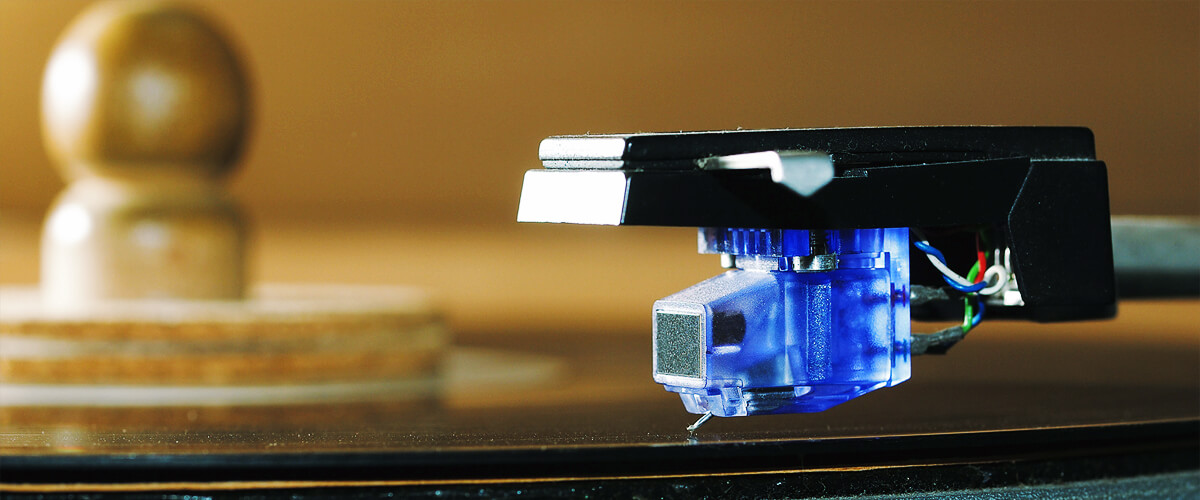
The cartridge mount is important for any tonearm, as it dictates which cartridges you can use with your turntable. Several mount types are available, such as standard (half-inch), P-mount (T4P), and proprietary mounts designed by specific manufacturers. So, carefully consider what mount type the turntable tonearm has, as this will impact the range of cartridge choices you can pair with your turntable.
Counterweight and anti-skate adjustments
These manipulations contribute to accurate tracking and prevent unnecessary wear on your vinyl records and stylus. In addition, the counterweight helps balance the tonearm and sets the tracking force, while the anti-skate adjustment counteracts the inward force that can cause the stylus to press harder against the inner groove wall.
Tonearm length and effective mass
These values have a direct impact on its performance and sound quality. Longer tonearms offer a shallower tracking angle error, reducing distortion and providing a more accurate sound reproduction. However, they can also increase the effective mass, which may affect resonance and responsiveness.
Tonearm materials and construction
Common materials of the record player needle arm include aluminum, carbon fiber, and stainless steel, each offering different advantages in terms of weight, rigidity, and resonance properties.
When it comes to build quality, a well-constructed tonearm minimizes vibrations and ensures stable, accurate tracking. So, you will have a cleaner and more enjoyable listening experience with top-notch detail.
Choosing the right tonearm for your turntable
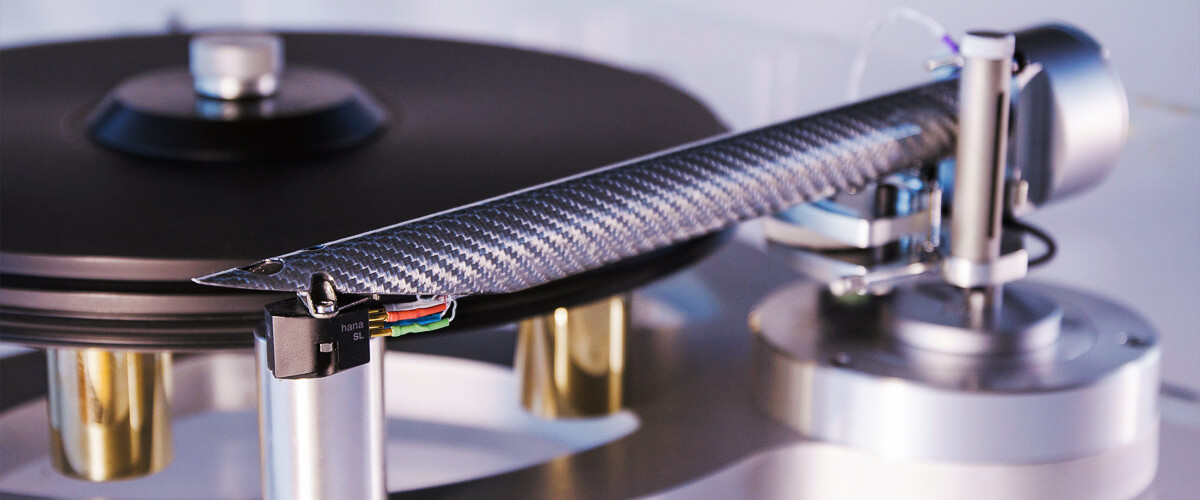
Since the tonearm you get for your turntable impacts your listening experience and the overall functionality of your setup, you have to make the right choice.
So, make sure the tonearm you’re considering is compatible with your turntable’s mounting system and design. Additionally, verify that the cartridge mount type aligns with the cartridges you plan to use or explore.
Furthermore, look for a tonearm that offers the necessary adjustments for tracking force, anti-skate, and alignment. This will ensure you can fine-tune your setup for optimal performance.
I also recommend considering the tonearm’s length and effective mass, as these factors will influence tracking accuracy, resonance, and responsiveness.
Finally, examine the materials and construction of the tonearm. After all, this will shape the tonearm’s performance, durability, and ability to minimize vibrations.
Setting up and adjusting your tonearm
So, you have finally bought a tonearm and now need to install and adjust it. Here are the steps I recommend you take:
- Attach the tonearm to your turntable, ensuring it’s securely fastened and properly aligned with the turntable’s mounting system.
- Carefully mount the cartridge onto the tonearm. For standard mount tonearms, align the cartridge’s mounting holes with the tonearm’s headshell slots and secure it using the provided screws. For P-mount tonearms, simply slide the cartridge into the tonearm’s end and secure it with the provided locking mechanism.
- With the cartridge installed, gently lift the tonearm and release the lock. Position the tonearm so that it hovers parallel to the platter without touching it. Adjust the counterweight until the tonearm floats freely and is balanced. Once balanced, carefully return this detail to its rest and lock it in place.
- Set proper tracking force. For this, consult the cartridge manufacturer’s recommended tracking force range.
- Locate the anti-skate adjustment on your turntable, typically a dial or slider near the tonearm’s base. Set the anti-skate value to match the tracking force you’ve previously set.
- Using a cartridge alignment protractor or the provided alignment tool, ensure that the cartridge’s stylus is properly aligned with the grid lines when placed on the protractor’s points. If misaligned, gently adjust the cartridge’s position within the headshell slots.
- Gently lower the tonearm onto a vinyl record and listen for any distortion, skipping, or sibilance. If you notice any issues, double-check your adjustments and fine-tune them as necessary. Repeat this process until you achieve optimal sound quality and tracking.
Maintaining your turntable tonearm
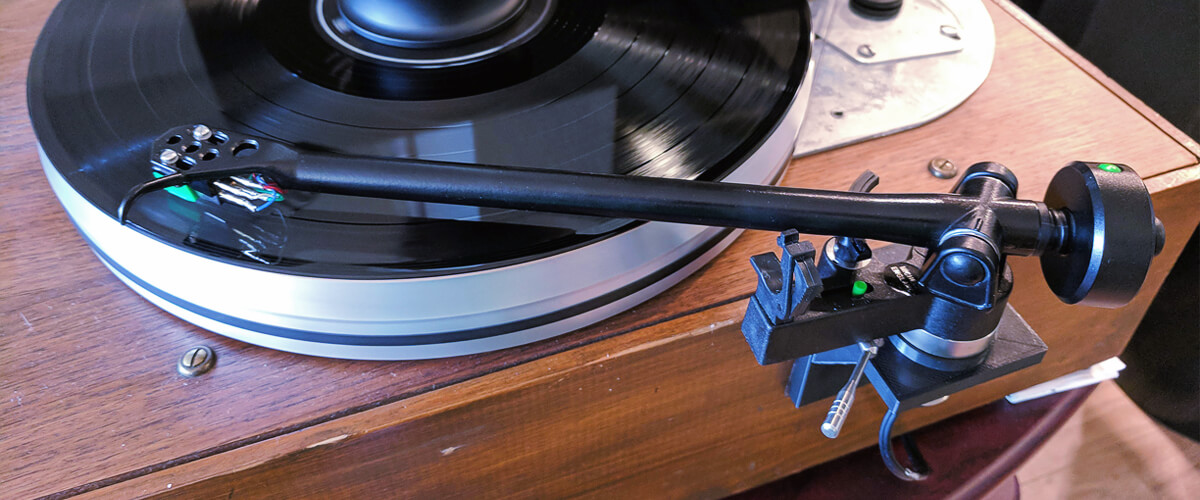
As someone who has spent years enjoying the captivating world of vinyl, I can’t stress enough the importance of maintaining your turntable tonearm. A well-maintained tonearm ensures a consistent listening experience and helps prolong the life of your records and stylus. Here are some tips I’ve learned over the years to keep your tonearm in top shape:
Regularly clean your tonearm
Dust and debris can accumulate on the tonearm over time, affecting its performance. Gently wipe the tonearm with a soft, lint-free cloth every few weeks to remove any buildup. Be extra cautious around the cartridge and stylus to avoid damage.
Check adjustments periodically
Over time, the tonearm’s counterweight, anti-skate, and cartridge alignment settings may drift. Regularly check these adjustments and fine-tune them as needed.
Lubricate the bearings
To keep your tonearm operating smoothly, lubricate the bearings occasionally. Refer to your tonearm manufacturer’s recommendations for the appropriate lubricant and application frequency.
Inspect for wear and damage
Periodically inspect your tonearm for any signs of wear, damage, or loose connections. Addressing these issues promptly will prevent more severe problems and ensure a consistent listening experience.
FAQ
Can a higher-priced tonearm really make a difference in sound quality?
Yes, a higher-priced tonearm can make a difference in sound quality. Premium tonearms often feature superior materials, construction, and precision engineering that contribute to better tracking accuracy, reduced vibrations, and improved resonance control. However, I recommend balancing your budget and preferences when deciding on a tonearm.
How do I know what tracking force to use with my tonearm?
The recommended tracking force for your tonearm is primarily determined by the cartridge you’re using. Cartridge manufacturers provide a recommended tracking force range for their products, which can usually be found in the cartridge’s documentation or on the manufacturer’s website.
Do I need to adjust the tonearm for different types of records?
In most cases, you won’t need to adjust the tonearm for different types of records if your tonearm is properly set up and calibrated. However, if you encounter issues such as skipping or distortion when playing specific records, it may be necessary to fine-tune your tonearm’s settings, such as tracking force or anti-skate.

